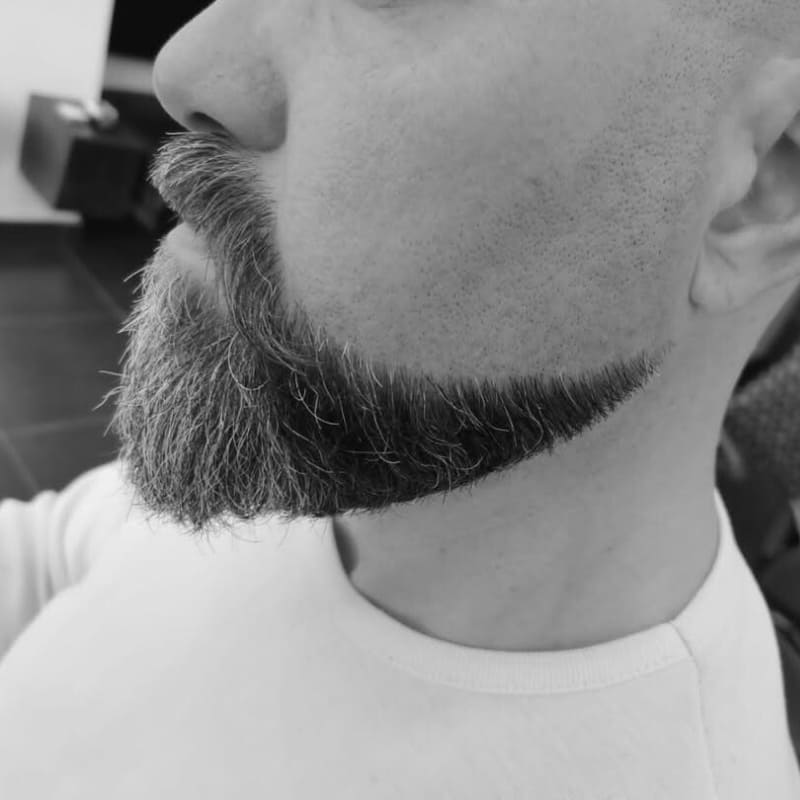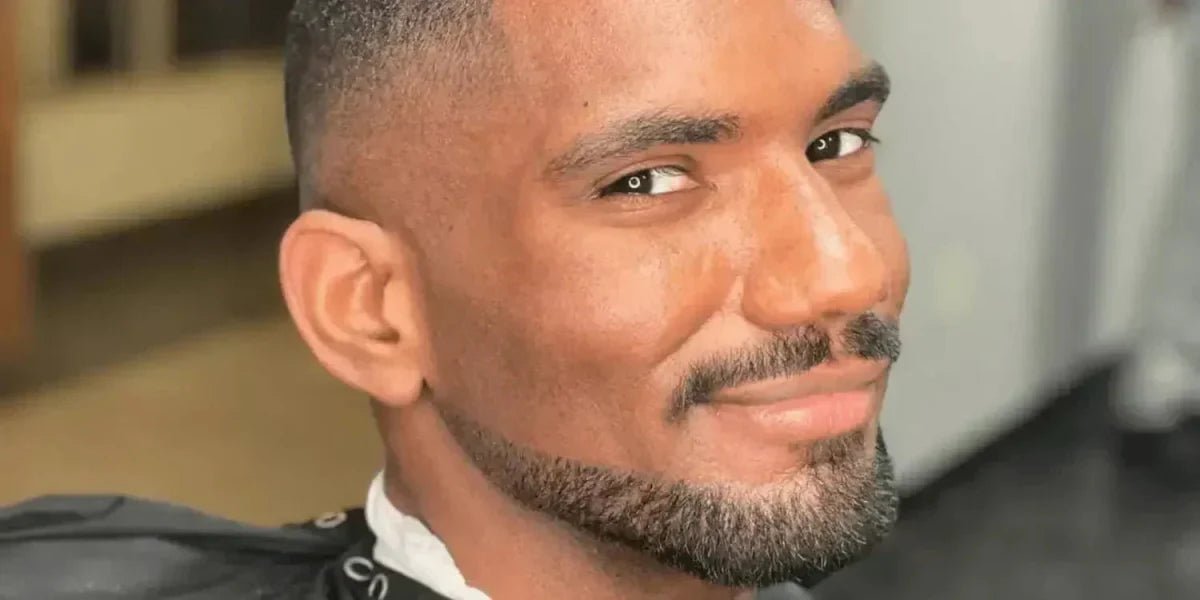The Balbo beard is a statement of precision. Built on sharp lines and purposeful disconnection, it blends clean control with minimalist confidence. It’s a style chosen by men who value detail over density—and who understand that less can often say more.
At Beard Beasts, we break down what defines the Balbo beard, how to grow and shape it properly, and the key maintenance habits that keep it looking intentional, not improvised.
What Is the Balbo Beard Style?

The Balbo beard is a structured, multi-part look defined by separation and clarity. It features a floating mustache, a defined soul patch, and tailored coverage along the jawline—deliberately excluding sideburns to maintain contrast between each region.
Its roots trace back to Italo Balbo, an Italian military leader in the early 20th century, who wore the style as a symbol of distinction and strength. Decades later, the look was reintroduced to modern audiences through Robert Downey Jr., whose angular, well-groomed take gave the Balbo renewed relevance in contemporary grooming.
But this style is more than historical reference or Hollywood polish. It represents intention. Every line is deliberate. Every detail contributes to a composed, masculine frame.
For men who prefer refined structure over casual fullness, the Balbo beard remains one of the most distinctive styles available today.
Is the Balbo Beard Right for You?
Not every beard suits every face—and the Balbo makes no attempt to hide that. Its structure demands balance, and its separated layout puts your natural features on display. That’s what makes it effective—but also what makes it specific.
This beard style works best for men with oval, square, or narrow face shapes. It draws attention to the chin and jawline, adding strength and proportion without relying on thickness.
For men with patchy cheeks or uneven growth patterns, the disjointed layout offers a smart solution—highlighting what’s strong while ignoring what’s not.
But this isn’t a beard you grow and forget. The Balbo requires control, commitment, and steady refinement. If you value clean lines, intentional grooming, and a beard that speaks with clarity, the Balbo will suit you. If not, it will likely work against you.
What Are The Different Balbo Beard Variations?
Below are six refined takes on the Balbo beard, each offering a distinct angle without straying from the style’s core identity.

Classic Balbo Beard
This version features a full mustache, a sharp soul patch, and balanced lower facial coverage that hugs the jawline. The edges are clean but not exaggerated, offering presence without demanding attention. It’s the most traditional take—sharp, contained, and widely flattering.
Extended Balbo
The chin portion is grown longer and slightly lower beneath the jaw, adding more vertical strength. It visually lengthens the face and gives the style greater impact without adding weight. Ideal for round or shorter face shapes seeking enhanced definition.
Narrow Balbo
This variation trims both the mustache and jawline area to a slimmer width for a more vertical silhouette. It suits men with lean or angular features who want refinement without extra bulk. The precision works especially well for those with limited growth across the cheeks.
Rounded Balbo
Instead of crisp corners, this version curves the outer lines for a softer finish. It retains the Balbo’s contrast but replaces angularity with more natural flow. A subtle variation that still reads as sharp and intentional.
Stubbled Balbo
The layout remains the same, but the facial hair is kept short and lightly detailed. This version offers minimal-maintenance grooming while preserving the Balbo’s distinct structure. It’s ideal for men who want subtle control without committing to full growth.
High-Contrast Balbo
This bold take pairs a tightly groomed Balbo with a clean shave or skin fade. The contrast directs full attention to the beard’s symmetry and edge control. It’s a striking, modern option for men who prefer clear boundaries and confident styling.
No matter the variation, the strength of the Balbo lies in its layout. Small adjustments in shape or length can refine the fit without diminishing its visual authority. Choose the version that best complements your features—and maintain every line with intention.
How to Grow and Shape a Balbo Beard
Growing a Balbo beard takes time, patience, and a clear understanding of how your facial hair develops. The goal is to build volume where it matters—then carve out clean form with precision.
Step 1: Commit to a Growth Phase
You’ll need at least two to three months of uninterrupted growth to build a solid base. Avoid trimming too soon—it’s important to understand your natural pattern first.
- Focus growth on the mustache, chin, and center beneath the lip.
- Let the soul patch grow freely—it plays a key structural role.
- Ignore the cheeks and sideburns, as they’ll be removed later.
- Do not trim during this phase, even if the beard looks unbalanced.
Step 2: Assess Growth Strengths
Before shaping, evaluate where your beard grows thickest and most evenly. The Balbo depends on targeted density, not uniform coverage.
- Strong mustache and chin growth are ideal for this style.
- Patchy cheeks won’t affect the final result.
- Fullness beneath the lip improves balance and proportion.
- Take mental notes of symmetry and coverage before trimming.
Step 3: Define the Structure
Once you’ve achieved enough growth, move carefully into shaping. Clean outlines and distinct spacing are what define the Balbo.
- Use a precision trimmer or razor to separate the mustache from the lower section.
- Shave the cheeks and remove the sideburns completely.
- Shape the lower beard to follow the jawline or extend beneath it.
- Keep the soul patch proportionate and neatly edged.
Step 4: Focus on Separation
The strength of the Balbo lies in the space between each section. Blurred areas or overgrowth will immediately weaken the style.
- Ensure there’s no connection between the mustache and chin area.
- Keep the cheeks and sideburns clean-shaven at all times.
- Define edges with symmetry and measured angles.
- Don’t round off corners unless you’re opting for a softer variation.
This beard style isn’t shaped by chance—it’s built through patience and purpose. With the right foundation and a deliberate approach to styling, it becomes a look that commands presence without force.
How to Maintain a Balbo Beard
Shaping is only the beginning—the Balbo demands consistent care to preserve its structure. Without attention, even the cleanest styling can begin to lose its strength.
Trim the Mustache Regularly
The mustache needs frequent upkeep to stay sharp and contained. Its division from the lower area is what anchors the whole look.
- Trim every few days to keep it just above the lip.
- Avoid letting it grow into the soul patch or lower beard.
- Use small beard scissors for greater accuracy.
- Comb daily to train direction and prevent curl.
Keep Zones Clearly Defined
The Balbo only works when each area remains distinct. Once the spacing begins to blur, the shape loses its clarity.
- Use a trimmer to maintain space between the mustache, soul patch, and jawline area.
- Re-shave the cheeks and sideburns weekly to prevent regrowth.
- Check for symmetry under strong lighting.
- Never let the sections reconnect or blend unintentionally.
Control Stray Growth
Stray hairs create visual distraction and weaken the effect of the design. Keep your routine sharp and purposeful.
- Tidy the upper cheeks, neckline, and jawline as needed.
- Remove stray hairs before they compromise edge control.
- Keep both sides consistent in length and proportion.
- Don’t rely on fading—sharp contrast defines this beard.
Condition and Style with Precision
Even the most angular beard needs softness, manageability, and subtle polish. Proper grooming enhances its presence without overwhelming the frame.
- Apply Beard Oil or Beard Butter daily to soften and nourish.
- Avoid heavy waxes or styling products that flatten or weigh down the shape.
- Comb or brush to control growth and direction.
Maintenance is where the Balbo either holds its edge—or quietly fades. Keep the structure intact, the spacing deliberate, and the routine consistent, and the look will always deliver.
Frequently Asked Questions
When it comes to this style, there are a few details men often get wrong—or simply overlook. These answers clarify the essentials so you can wear the look with confidence and accuracy.
What is a Balbo beard?
A Balbo beard features a disconnected mustache, a separate soul patch, and a chin-framing beard with no sideburns. Its structure is clean, deliberate, and meant to highlight facial shape through contrast.
How long should a Balbo beard be?
It usually takes two to three months to develop enough length in the right areas. Final length depends on face shape and variation, but it must support separation and clarity.
What’s the difference between a Balbo and an anchor beard?
An anchor beard connects the mustache and chin hair in a point, forming an anchor shape. The Balbo keeps all zones separate, allowing for more customization and cleaner spacing.
What celebrity has a Balbo beard?
Robert Downey Jr. is the most recognizable wearer of the modern Balbo. His version helped redefine the style with sharper angles and controlled length.
How do you line up a Balbo beard?
Remove all cheek and sideburn growth, then shape each section independently. Use a precision trimmer to define clean, symmetrical edges across the chin and upper lip.
Can you wear a Balbo beard without a mustache?
No—a disconnected mustache is a signature element of the Balbo. Without it, the look shifts toward a goatee and loses its defining contrast.
Final Questions
The Balbo beard stands apart because it’s built on precision, not excess. Every line is intentional, every gap deliberate—designed to frame the face with clarity and control.
It doesn’t rely on fullness to make its presence known. Instead, it sharpens your features through spacing, structure, and disciplined grooming.
What makes this beard style effective isn’t just how it looks—but how it’s maintained. Without routine care, its strongest asset—shape—quickly fades.
That’s why this style suits men who take grooming seriously. It’s a beard that demands presence, not passivity.
Whether you wear it short and crisp or opt for a longer, more structured version, the Balbo always reflects control. There’s no guesswork—only execution.
And at Beard Beasts, that’s what we value most. Grooming that’s sharp, strategic, and built to elevate.





